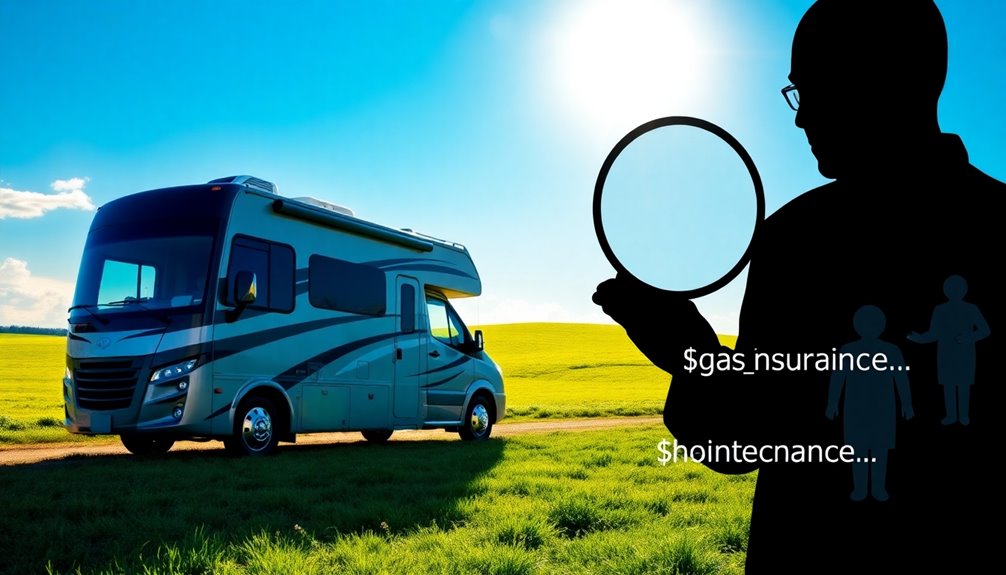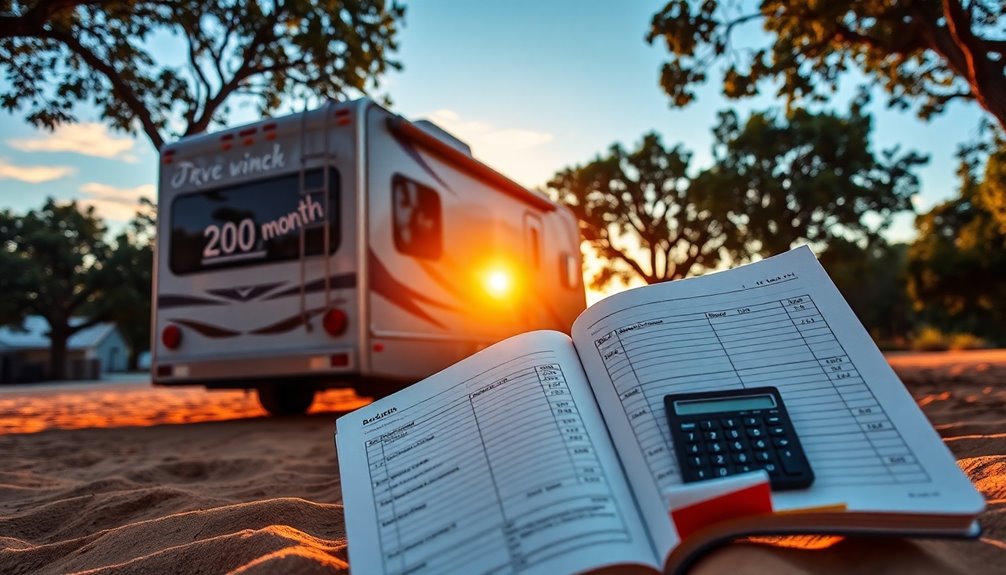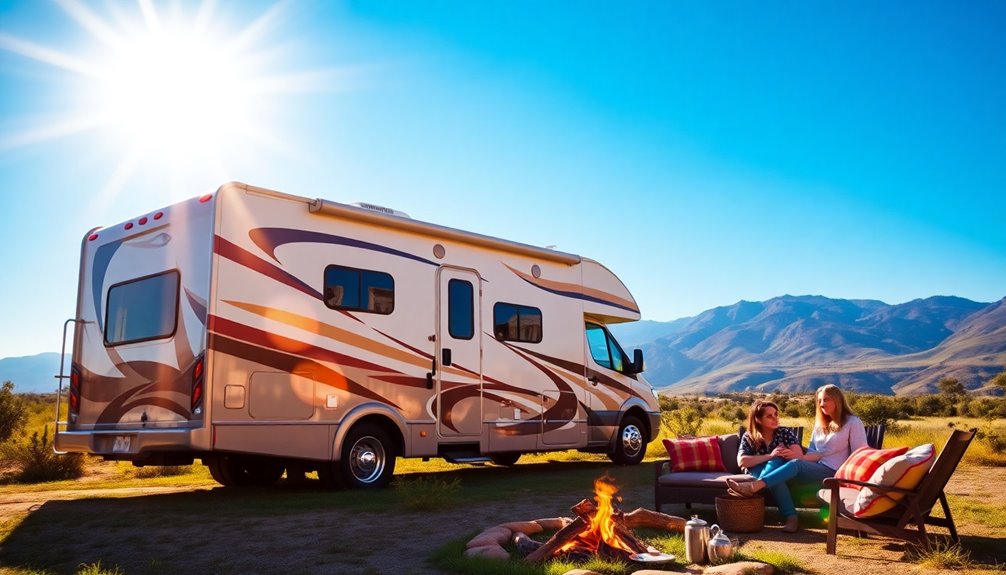An RV rental for $200 a month probably isn't as good as it sounds. The average monthly cost typically ranges from $1,500 to $3,000, and you'll often encounter hidden fees like mileage charges and cleaning costs. Even long-term discounts rarely bring prices below $1,500. While there may be some outlier deals, they might come with strings attached, like poor RV conditions or limited services. Keep an eye out for additional expenses that can quickly add up. If you think it sounds too good to be true, you're right—there's much more to reflect upon before signing on the dotted line.
Understanding RV Rental Costs
When you're considering RV rentals, it's vital to grasp the true costs involved. The average nightly rental cost for RVs hovers around $183, which can lead to a staggering $5,490 for a month-long rental. If you're thinking about a $200 monthly rate, you're well below market value.
RV rental companies typically charge more, especially for Class A motorhomes at $306 per night, Class B campervans at $232, and Class C motorhomes at $212. Additionally, using expense management apps like Fyle can help you track these unexpected costs more effectively.
You also need to factor in additional costs like mileage fees, which average $0.35 per mile, and cleaning fees that can range from $100 to $300. These can greatly increase your total costs, making that low monthly rate even less realistic. Regular monitoring of investment performance can also help you understand the financial implications of such a rental.
Insurance costs are another factor, often required for RV rentals, adding an unanticipated expense to your budget.
While long-term rentals may offer discounts on RVs, even these discounts don't usually bring prices down to $200 a month. Understanding these aspects of RV rental costs is vital before making any decisions. Monitoring savings and investments is crucial to ensure you're fully prepared for the financial commitment involved.
Breaking Down the Pricing Structure
Understanding the pricing structure of RV rentals is essential for anyone looking to hit the road without breaking the bank.
When you explore RV rental pricing, you'll quickly see how a $200 monthly rate just doesn't add up.
Here's a breakdown of typical rental costs:
- Nightly Base Rate: The average nightly rental cost varies greatly, from $60 for Fifth Wheels to $306 for Class A motorhomes.
- Mileage Fees: Expect to pay around $0.35-$0.45 per mile, which can add up quickly on longer trips.
- Additional Expenses: Rental agreements often include fees for kitchen utensils, bedding, cleaning, and insurance that inflate the overall cost. Additionally, keeping track of these fees can be managed more effectively with expense categorization tools, which help streamline financial reporting. Furthermore, utilizing detailed insights and reporting from expense tracking apps can enhance your understanding of all associated costs.
- Long-Term Rentals: While you might negotiate better rates for monthly rentals, even discounted prices rarely dip below $1,500-$2,000.
With these factors in mind, the cost to rent an RV isn't just about the base fee.
Additionally, it's wise to utilize bill tracking tools to keep tabs on all associated expenses as they arise.
Consider all rental fees and additional expenses before getting too excited about that tempting $200 offer.
The reality is that legitimate RV rentals will likely exceed your budget.
Hidden Fees to Watch For

Hidden fees can turn that enticing $200 monthly RV rental into a costly venture before you know it. Many rentals advertise low rates, but the base price often excludes crucial extra expenses.
For instance, mileage fees can range from $0.35 to $0.45 per mile, which can quickly add up if you plan extensive travel. Budget apps can help you track expenses effectively to avoid overspending on these additional costs. Using tools like Zoho Expense can further enhance your expense management process.
Additionally, rental agreements may list extra costs for kitchen utensils, bedding, and delivery fees that aren't disclosed upfront. These hidden fees can greatly inflate the total cost.
Don't forget about taxes and rental insurance, which can increase your overall expenses by 10-15% or more, depending on local regulations.
It's also important to pay attention to security deposits, which can range from $500 to $3,000. This amount could be withheld for any damages or cleaning issues when you return the RV.
To avoid surprises, make certain to read the fine print in your rental agreement thoroughly. Understanding these hidden fees will help you budget more accurately and guarantee your RV rental experience remains enjoyable and within your financial means. Additionally, conducting regular billing process reviews can help prevent unexpected costs from accumulating throughout your rental period.
Evaluating Monthly Rental Offers
As you explore monthly RV rental offers, it's essential to dig deeper than the eye-catching price tags. A rental price that starts at $200 might sound appealing, but it often comes with strings attached.
Here's what to take into account:
- Hidden Costs: Be wary of mileage fees, generator usage, and other additional charges that can inflate your total expense.
- Average Monthly Rental: Typically, the average monthly rental for an RV ranges from $1,500 to $3,000. If an offer seems too good to be true, it likely is, especially when compared to major price comparison platforms that can provide insights on typical rental prices. Additionally, using comprehensive price comparison features can help you identify any discrepancies in rental offers.
- Long-Term Rentals: Many rental companies provide discounts for long-term rentals, so check if you're eligible for better rates.
- Verify RV's Condition: Always inspect the RV's condition and the reputation of the rental company to avoid unexpected issues.
- Price Comparison Tools: Utilizing price comparison tools can help you evaluate different rental offers and ensure you're getting the best deal.
Tips for Staying on Budget

To keep your RV rental costs in check, you need to monitor your mileage and plan your routes carefully. Look for long-term discounts that can save you money on rentals. Additionally, consider investing in sustainable practices that can help reduce your overall expenses while supporting eco-friendly initiatives. By choosing ethical shopping options, you can contribute to a more sustainable economy and make a positive impact on the environment. Engaging in sustainable delivery practices can further enhance your eco-friendly approach while minimizing your carbon footprint.
Monitor Mileage Usage
Monitoring mileage usage is essential for keeping your RV rental budget in check. Many rental companies charge between $0.35 to $0.45 per mile for any distance driven beyond your included mileage limit.
To avoid these additional fees, consider these tips:
- Plan Your Routes: Estimate total travel distances in advance to help avoid unnecessary mileage charges.
- Use Fuel Apps: Utilize apps like Gas Buddy to find the lowest fuel prices along your route, which aids in budget management.
- Track Generator Usage: Keep an eye on generator usage, as many RV rentals incur charges of around $4.00 per hour beyond the allowed limit.
- Maintain Fuel Efficiency: Regularly check tire pressure and avoid excess weight to improve fuel efficiency, ensuring you stay within your mileage budget.
Plan Route Efficiently
Planning your route efficiently can greatly impact your RV rental budget. By carefully planning your route, you can control mileage costs, which often incur additional fees of $0.35 to $0.45 per mile beyond your rental limits. Use online mapping tools to estimate distances accurately, helping you avoid overage charges during your RV rental.
Make campground reservations ahead of time to save money; off-season rates are generally lower than peak season pricing. Additionally, look for pull-through RV sites when planning your route. They offer easier access and convenience, minimizing the time you spend parking and maneuvering.
Don't forget to monitor fuel prices along your route. Apps like Gas Buddy can lead to significant savings, especially considering that RVs typically incur fuel costs of $200 to $500 for every 1,000 miles driven.
Seek Long-Term Discounts
Seeking long-term discounts can greatly lower your RV rental expenses. Many RV rental companies provide significant savings for extended rentals, and taking advantage of these can make your travels more budget-friendly.
Here are some tips to find the best deals:
- Book During Off-Peak Seasons: Rates often drop outside peak travel months, so consider timing your RV rental accordingly.
- Utilize Online Rental Platforms: Websites allow you to compare prices and discover special deals or promotional codes that can reduce costs further.
- Look for Long-Term Discounts: Rentals lasting a month or more usually have lower nightly rates, which is ideal for extended travel.
- Negotiate Discounts on Peer-to-Peer Platforms: Many RV owners are open to negotiating prices, especially for longer rentals, so don't hesitate to ask for a better rate.
Comparing Rental vs. Ownership Costs
When considering the costs of RV travel, it's vital to weigh the financial implications of renting versus owning. Renting an RV can seem appealing at first, especially with offers like a $200 monthly rental. However, the average nightly cost for RV rentals ranges from $50 to $306, indicating that this rate is considerably lower than typical prices, which could suggest hidden fees or unrealistic expectations.
Ownership costs can add up quickly. In addition to the initial cost of an RV, you'll face ongoing expenses such as maintenance, storage, insurance, and depreciation, which can total thousands of dollars annually. When renting an RV, you avoid these long-term ownership costs.
However, be aware that rental services often charge additional fees for mileage, generator use, and cleaning, which can inflate your total expenses.
If you're considering long-term RV rentals, discounts may apply for rentals of three months or more. Still, a $200 monthly rental may not be feasible given the typical pricing structures of rental companies.
Ultimately, weigh the potential savings of renting against the hidden costs to make the best decision for your RV travel needs.
Benefits of Long-Term RV Rentals

Long-term RV rentals offer a fantastic way to enjoy the freedom of the open road without the financial burdens of ownership. They provide a cost-effective alternative to traditional hotel stays, perfect for budget-conscious travelers.
Here are some key benefits of choosing long-term RV rentals:
- Flexibility: You can test different RV types and models before deciding to buy, ensuring you find the perfect fit for your travel style.
- Significant Savings: Many rental companies provide discounts for longer rental durations, leading to substantial savings compared to nightly rates.
- Cooking Meals: With an RV kitchen, you can prepare your favorite meals on the road, reducing food costs and enhancing your overall travel experience.
- Avoiding Ownership Costs: Long-term rentals help you sidestep maintenance and ownership expenses, allowing you to focus on enjoying your adventures.
Finding Reliable RV Rental Services
Maneuvering the world of RV rentals can feel overwhelming, but finding reliable services simplifies the process. Start by exploring trusted RV rental services like RVnGO, which features verified RV owners and offers thorough customer protection, including roadside assistance and damage coverage.
Consider using peer-to-peer rental platforms such as Outdoorsy and RVshare, where you can conduct extensive searches by location, dates, and amenities. These platforms often vet their hosts, ensuring safety and reliability while providing access to a diverse selection of RVs.
If you're looking for long-term RV rentals, many services offer flexible durations, sometimes up to two years, catering to your travel and living needs.
Don't hesitate to negotiate directly with RV owners for long-term stays; this can lead to discounted rates and make your rental more affordable.
Conclusion
In the world of RV rentals, think of yourself as a savvy traveler steering through a winding road. While a $200 monthly rental might shine like a tempting oasis, remember to check for hidden potholes. Keep your eyes peeled for extra fees and compare your options carefully. By staying informed and budgeting wisely, you'll find the right path that leads to adventure without breaking the bank. So, gear up and enjoy the journey—just watch out for those surprise turns!



